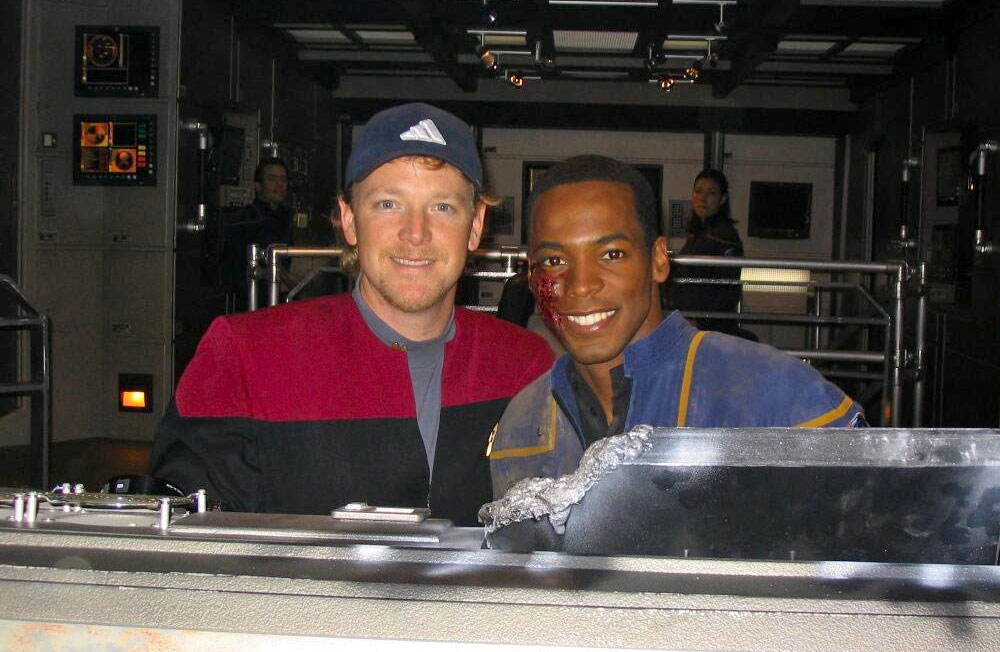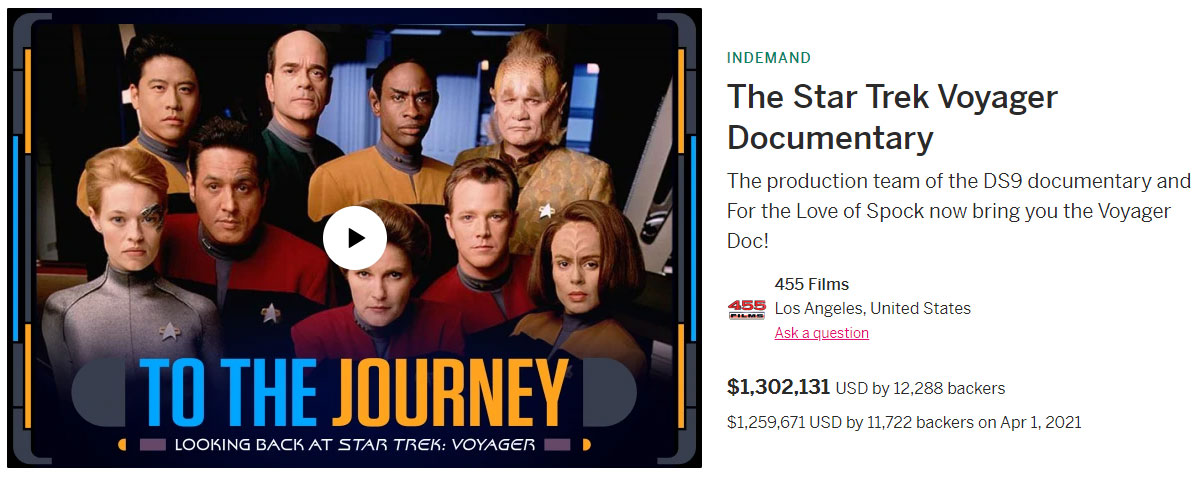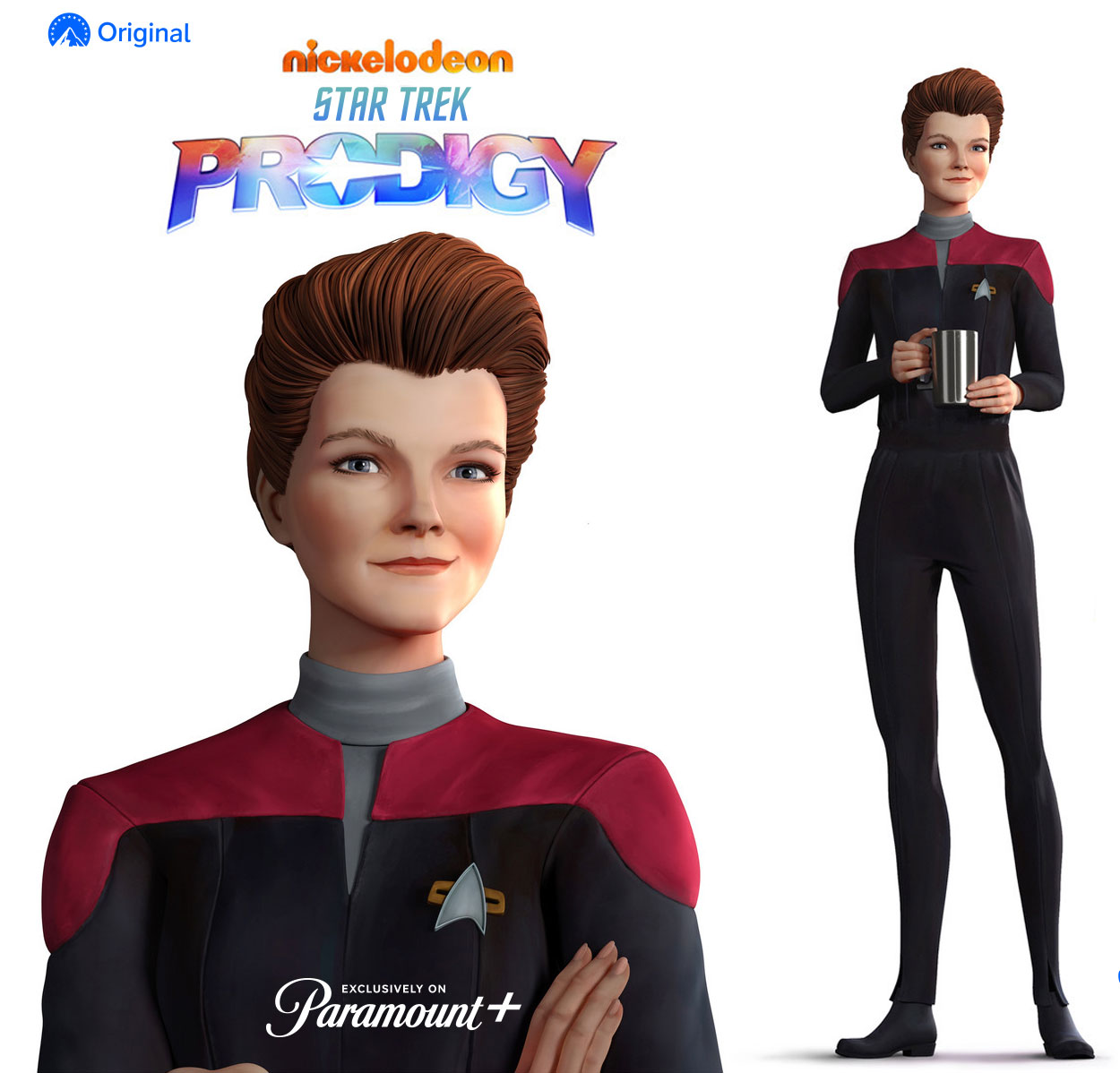After blasting well past the $1 Million mark in their month-long fundraiser, the team from 455 Films behind the Star Trek: Voyager documentary project — To the Journey: Looking back at Star Trek: Voyager — now have the daunting task of shooting, editing, completing post-production, and more for the film before fans will see what their donations have paid for.
With the largest hurdle behind them, we spoke with To the Journey director David Zappone, who also produced For the Love of Spock, Chaos on the Bridge, William Shatner’s The Captains, and of course, the much-loved Deep Space Nine documentary What We Left Behind, which he also co-directed.
In our discussion, we spoke about the surprise of raising so much money so quickly, the impact of the COVID-19 pandemic on production, the challenge of remastering Voyager footage for high-definition use, and more.
While the interview below has been edited and condensed for clarity, you can hear the full discussion between our Alex Perry and To the Journey director/producer David Zappone on this special edition of the WeeklyTrek podcast.
TREKCORE: First of all, $1.3 million in fundraising is a colossal achievement. Were you expecting that outpouring of support from fans?
DAVID ZAPPONE: No! I always thought that we would do as well as the Deep Space Nine documentary, but I believe what’s happened here is we built upon the Deep Space Nine audience, and we were savvy enough to make them all aware that this was coming. The difference between this campaign and Deep Space Nine is that we have a guy named Ryan Husk, one of the hosts on The 7th Rule podcast, as campaign manager.
His advice immediately was, “Let’s build up the anticipation!” because in the previous campaigns, For the Love of Spock and What We Left Behind, we waited until the day of the launch to start building up awareness.
He wisely advised us to take the two months to build up that. We did and my God, I think we made $450,000 the first day. Incredible.
TREKCORE: Yes. It beat out the Deep Space Nine campaign within the first two days!
ZAPPONE: I just want to be very clear in that this would not have happened without Deep Space Nine and the fact that I think all of our work has been embraced going back to The Captains.
We’ve really done some very affectionate pieces on Star Trek but I think it’s the overwhelming love of What We Left Behind that is responsible for this success, and the fact that Voyager is a terrific show and people love these characters.
Look at the situation we’re in, where we have Kate Mulgrew (Janeway) back in Prodigy, Jeri Ryan (Seven) and John de Lancie (Q) back now for Picard — so it seems like a great time to be doing something for Voyager.
TREKCORE: What stage is the Voyager documentary at now, with your first interviews coming just before pandemic lockdowns started happening throughout the world — and what are your current priorities for the project?
ZAPPONE: We didn’t stop totally during COVID. I have to say we also couldn’t have done it without Garrett Wang (Harry Kim). Garrett has been such a supporter, and helped us with the launch immensely, as you’ve probably seen on social media and in our pitch video, and Tim Russ (Tuvok) and Robbie McNeill (Tom Paris), and Ethan Phillips (Neelix), Alice Krige (Borg Queen), everyone, and let’s not forget Connor! That’s actually my favorite part of the– [laughs] Just when Connor Trinneer (Enterprise’s Trip Tucker). pops up.
We filmed a very extensive interview during COVID with Garrett — in person, because I do not want to resort to Zoom for this production — and we were able to get a very extensive interview with Robbie McNeil before he left for directing work in Canada. Others too, like Brannon Braga and Andre Bormanis.
I did not want to stop totally during the pandemic, and lose our momentum. We have done some interviews but now it’s akin to Deep Space Nine. We went into the crowdfunding with a good amount of it under our belt but this allows us to now do this right.
We are now looking at studios, we are hopefully going to be able to build a set to film in-person interviews like we did with What We Left Behind. Our priority now is really logistics, figuring out where to shoot.
The difference here is this cast is a bit spread out over the country. We might need multiple stages. I intend to do what we did with What We Left Behind. I’m not going to limit it to just the actors.
We’re about to interview series co-creator and showrunner Jeri Taylor; as many people know she hasn’t contributed to anything like this in a long time, but we’re going to be traveling to her and interviewing her in person. Rick Berman has already said yes.
We intend to go hopefully as deep into the production side and the writing side, as we did in What We Left Behind.

TREKCORE: You’re still early in to the ‘story’ development for the film, but do you have particular parts of Voyager’s history that you’re already eager to dive into — like Mulgrew’s turn as the first lead-role female captain?
ZAPPONE: Absolutely. Yes, you hit it right there. It’s the influence of these incredibly strong women on that show. Of course, it’s primarily Kate, but it’s Roxann Dawson (Torres), Jeri Ryan, and I would argue for Jennifer Lien (Kes) in the early seasons. Yes, the impact of how that changed television, and how that led to this whole revolution in STEM for women. That’s an avenue that we’re going to be exploring.
The other thing that’s interesting to me is the fact that the show was on a network it helped launch — UPN — I want to delve into that and the pressures that the producers were feeling… but I’m hoping to get the Paramount-side point of view as well.
But it’s really is up to the people that were involved — and where those stories take us — that will determine our role. I never go into these documentaries with a roadmap. We have an idea of the questions that we want to ask, but really, it’s going to depend on where the interviews take us.
TREKCORE: Several of us have been speculating wildly about the million-dollar “never-before-seen Voyager surprise” teased on the Indieogogo campaign… any hints?
ZAPPONE: I wish I could get into detail, but I really can’t.
From the Deep Space Nine film, I learned that this kind of project can’t just be talking heads; you can’t just cut from interview to interview to interview to interview to episode clip. We need something more than that, and for What We Left Behind, the “DS9 Season 8 Writers’ Room” segment gave us that.
For Voyager, the truth is, we’re not sure yet exactly what kind of ‘surprise’ we are going to do — because we don’t own Star Trek. I will say, though, that we’re hoping to do something with the actors themselves, which will take a lot of negotiation and approval.
We have very high aspirations!
TREKCORE: What’s the most surprising thing you’ve learned about Voyager from the work you’ve done so far for the documentary?
ZAPPONE: Well, certainly, I’d heard what everybody else heard which is, “Oh, Voyager was not that great.” “The cast doesn’t get along.” I heard all these rumors. I was a fan from the jump, from 1995. I was in. I didn’t believe any of that. I knew the show was quality. There’s so much crossover between the creative from Deep Space Nine, Next Generation, Voyager, it’s the same group.
But also, being told by some people, “Well, there’s not a strong enough fan base for Voyager.” That’s the biggest surprise — and wow, did they underestimate the passion of these fans!
Let me just touch on the Star Trek Cruise. I can’t tell you how fortunate we are to have been on that last year — it was the only physical reunion that the Voyager cast had, since everything else was cancelled by the pandemic. More than that, the company that runs the Star Trek cruise let us use their Broadway-quality theater that they have on the ship.
The days on that ship were some of the longest days I’ve ever had in production. We were working 18 hour days, and happily. We just invited fans to come in and just tell us about what Voyager meant to you. That’s where I realized that Voyager fandom really runs deem — and it’s got a lot of younger people in it, too
It’s not just people my age who watched it the first time around, it’s garnered an entire fandom, just like Deep Space Nine, an entirely new fan base from streaming. I think the episodic nature of Voyager lends to that. Yes, the metric that I’ve heard and everybody’s heard is that I think six out of the top 10 streamed Star Trek episodes on Netflix are Voyager. Now I get it.
TREKCORE: Will the film touch on the “continuing voyages” of the Voyager crew — like Jeri Ryan coming back for Picard and Kate Mulgrew returning for Prodigy?
ZAPPONE: Oh, absolutely — I can’t imagine that we would not cover that. I’m not going to limit it and just stop at “Endgame,” because the story doesn’t stop there. I mean did you see that terrific animated Janeway in the First Contact Day panels?
And what is she holding? That iconic coffee cup, which is proven to be one of our most popular Indiegogo perks — the demand for that coffee cup replica was one of the biggest surprises of the fundraiser.
I wish I could take credit for that — but that came from Paul Camuso who runs the William Shatner store. He said to me, “You know, Dave, I know the company that made that coffee mug they used in Voyager, and we can get them recreated. People will want that mug!”
I’m blown away by the success of it.
TREKCORE: I’ve got to ask about your plans to remaster Voyager footage into high definition. Will you be using the same methods as you did for the DS9 documentary, assuming you get the green-light from CBS?
ZAPPONE: We’ve discussed everything with CBS and I can’t imagine that they’re going to have a problem with letting us move forward; they were thrilled with how well our DS9 remastering work turned out. We have so much DS9 footage, you wouldn’t believe how many hours we scanned.
That said, CBS Digital — the company that we used for the DS9 remastering, who also did the work for the Next Generation Blu-ray project — no longer has their enormous scanning machines to scan the film, so now we need to find a new company and a new way to do this.
That part of the process is very difficult.
TREKCORE: We know that CBS doesn’t have easy access to a lot of the original Voyager CGI effects shots, because they didn’t have a preservation method in place.
ZAPPONE: No, and you you’d have a tough time finding computers to even run those. Those are all ancient computers at this point.
TREKCORE: Given that Voyager relied more heavily on CGI than Deep Space Nine did, is that going to make it more challenging to include some of the show’s effects sequences, like that high-def “Sacrifice of Angels” clip?
ZAPPONE: I don’t think so. Because we’re going to use the same brilliant effects people that we use on What We Left Behind. We have access to a lot of those original files through Ben Robinson, who runs the Star Trek Starships Collection for HeroCollector.
Plus, we’ve got people like Dan Curry, Mike and Denise Okuda… everybody is helping us. We’re going back to the original people that worked on the show to help us recreate these sequences.
I don’t think it’ll be any more difficult — at least I hope not.
TREKCORE: So with all that said, what’s the timeline look like for the project, from now to a world premiere?
ZAPPONE: Well, I’ve been kind of careful in my predictions, only because of COVID and what it’s done. I’m speaking to you from from Paramount Studios which for three months was closed down and we couldn’t access its facilities.
I was informed three hours before it was shut down last year, meaning our editor had to rush over here, grab all the computers, hard drives, and everything else, and get out — and if we hadn’t done that, we would have gone for months without anything to work with, even our footage from the cruise.
I’m very optimistic, now that vaccines are rolling out and things are opening up; I mean, things are looking pretty good here in Los Angeles. As long as we continue on this course, I’m hopeful for fall-winter of 2022.

TREKCORE: Finally, with all you’ve worked on in your previous projects, and this Voyager one… have you thought at all about turning your attention to Star Trek: Enterprise?
ZAPPONE: You know, I could be evasive, and give you some kind of cheeky answer — but of course, I would love to tell the story of Enterprise. Absolutely I would.
I’ve become very close with those actors. It didn’t go the seven years the other shows went, but they did amazing work in that series. I would be remiss, I think, in stopping here.
Yes, my intention is 100% to move on to Enterprise.
![]()
For more of this discussion with the film’s director/producer David Zappone, be sure to listen to the extended interview on this special edition of WeeklyTrek.
We’ll keep bringing you all the latest news on To the Journey: Looking Back at Star Trek: Voyager as we move closer to the film’s release!



